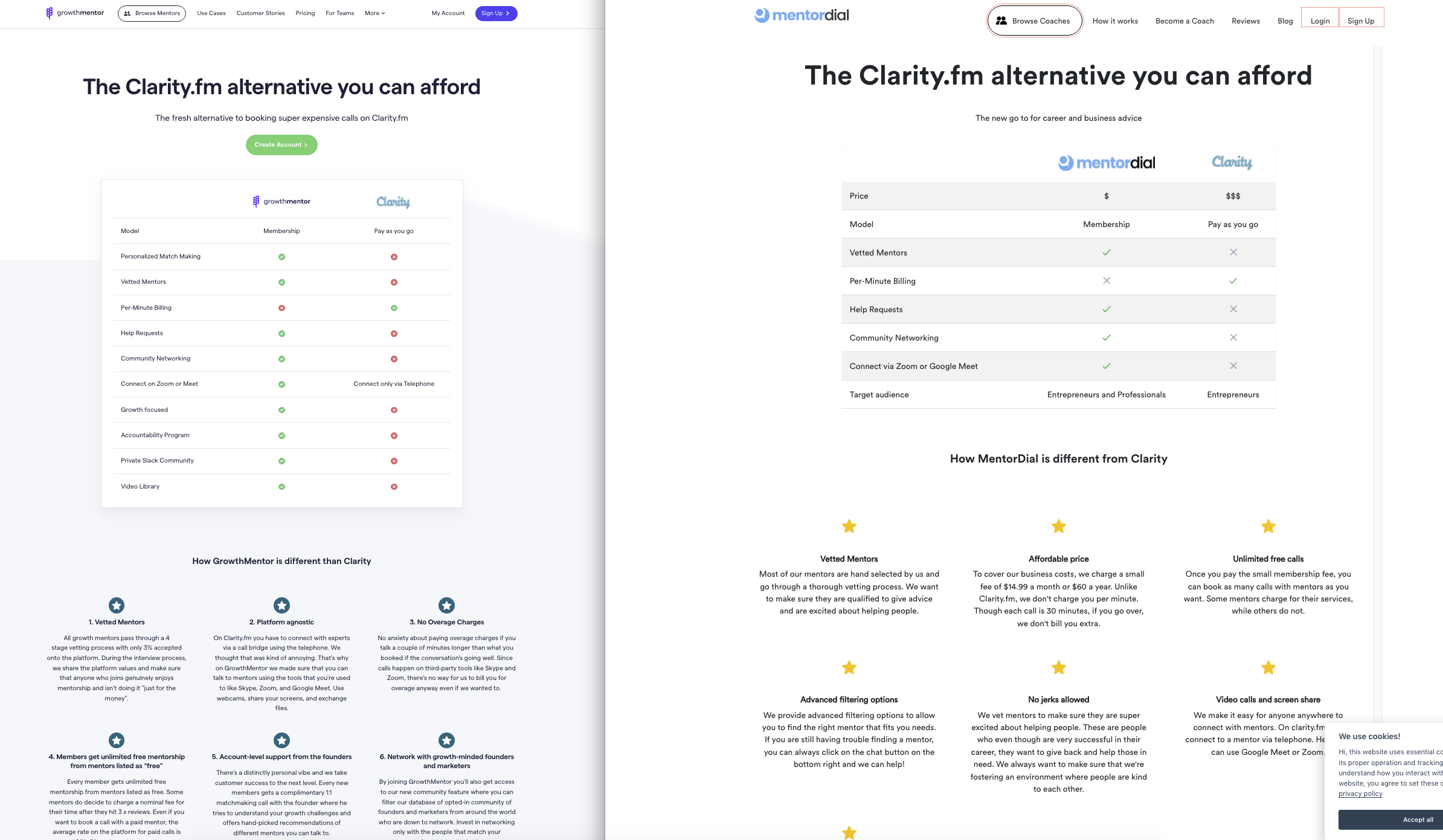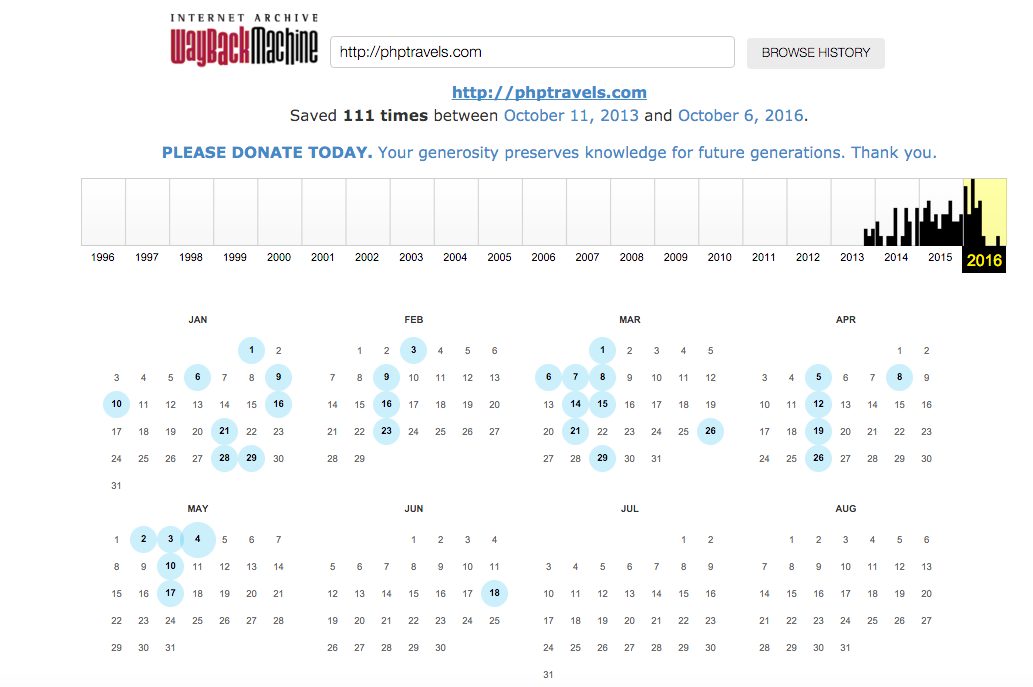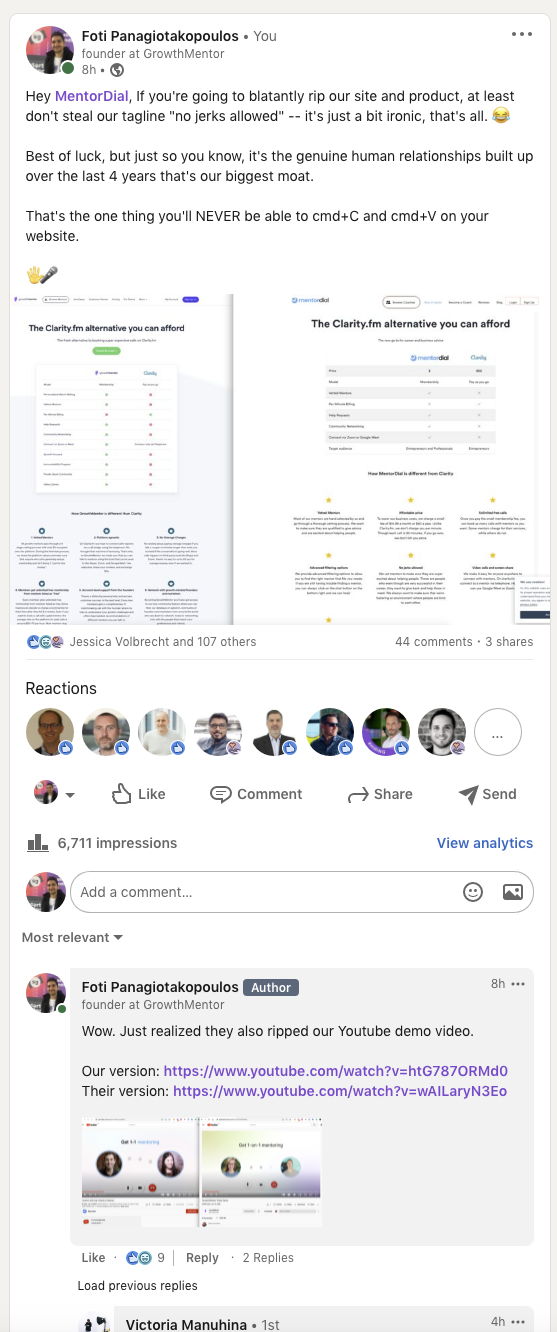How to Deal with Content Theft (MentorDial.com Case Study)
If your website’s content has been stolen, you are not alone.
Click the screenshots below to see how MentorDial shamelessly copied us.
Considering the delicate nature of the mentorship industry, we feel it’s our obligation to expose bad actors in this space.
Being a mentor is a responsibility and privilege which requires a certain threshold of ethos and integrity.
This is why we thought it a good idea to create an in-depth post that will go over some steps you can take if you’re in a similar situation.
My intention is to give you an actionable playbook on how to get your stolen content removed without spending money on expensive legal battles.
But first, let’s talk about why some people shamelessly resort to content theft in the first place.
Why do people steal web content?
Content Scraping for BlackHat SEO
Content “scraping” is a full-time job for many black-hat SEO artists to build content quickly for PBN sites.
They purchase expired domain names that have legacy Domain Authority and Trust Flow and build dummy sites on them.
Their ultimate goal is to use these spammy sites for link-building purposes.
But creating original content for these sort of sites is expensive and collapse the ROI of the project. Stealing content, and other unethical marketing tactics on the other hand, is faster, easier, and cheaper.
Big ambitions with limited resources and skill
Another reason why people steal content is that they see a competing website in their niche that they feel is exactly what they need.
These “businesses” have the ability to spot value in others’ but do not have the ability to actually create it themselves.
Hiring and managing a team of employees to create an industry-leading product, website, or brand kit is usually out of budget for them, so they resort to theft.
Classifying Content Theft
Some types of content theft are more damaging than others. When investigating, it is important to appraise the scope of damage you’re dealing with.
Isolated theft of your icons or specific phrases within your text (but not in its entirety) are enough to cause an annoyance, but they’re not business inflicting.
When to get involved
If the content theft affects your search rankings and brand reputation then you need to get involved immediately before it escalates.
When entire pages of text are being stolen, or your entire custom icon set is used without permission, you are left with no choice but to try and have this content removed.
Detecting Content Theft
Check your content with CopyScape
The first step to protecting yourself from copy scrapers is to know whether you’ve been copied in the first place.
Let’s start by discussing how to find out if your web content has been stolen.
CopyScape is the best tool online to learn if one of your pages has been ripped. Simply enter your URL and press search.
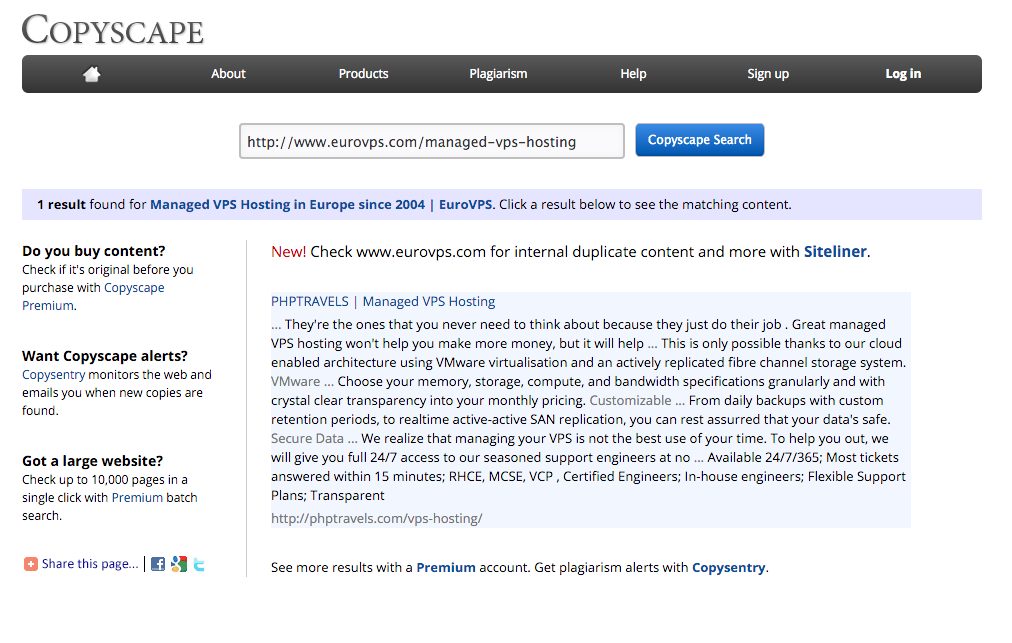
Pro Tip: The free version will do just fine. The only reason anyone would ever need the premium version is for bulk text upload. But for scanning URL’s, the free version of CopyScape is all that you will need.
Documenting Content Theft
Once you discover content theft, immediately take screenshots of all instances you can spot.
- Make sure to document every single instance no matter how trivial of a copy it is.
- Document the dates of screen capture and preferably take one copy per day to create a sort of change log
- You want to have proof before the perpetrator removes the stolen content, and deny the true extent of the theft.
- Compile all your screenshots into a .PDF file and share it with your legal team, hosting provider, or whoever else needs to get involved.
- This will be your strongest weapon against the thieves!
Contacting the Content Thief
Sending a Cease and Desist Letter
A Cease & Desist Letter is the first official acknowledgement that states you are aware of their activity and want them to stop.
The purpose of the letter is to let them know that further legal action is on the table if they do not remove the content.
Nobody likes dealing with lawyers. The chance of serious legal repercussions will in most cases be enough to get them to remove the content.
Pro Tip: If the website doesn’t have any contact information try running on “Whois” on the domain name. If the domain has privacy enabled then you’ll have to escalate the matter to the hosting provider.
Innocent Until Proven Guilty
Keep your cool in your initial outreach because often the site owner has absolutely no idea they have stolen content on their site.
For example, the content might have been uploaded by a 3rd party contractor.
It happens all the time that digital marketing agencies outsource unvalidated freelancers who submit plagiarised web copy (Always check your content writers’ work with CopyScape to avoid this).
These are common situations that a professional yet assertive cease and desist email can easily solve.
If they reply in any way other than with an apology and time schedule on when they will remove the stolen content, don’t waste anymore time on them.
Move on to your other options.
Some people decide to skip this step and move directly to contacting their hosting provider. This is a mistake because most hosting providers have rules that state they’ll only intermediate if you have shown attempts to diffuse the situation directly.
Filing a DMCA Takedown Notice to Host
If the cease and desist did not work, send a DMCA takedown notice to the thief’s hosting provider. Filing a DMCA complaint to a hosting provider is easy.
Fill in this wizard to have it auto-created for you or read this guide to learn how to create a slightly more professional hand-crafted DMCA notice.
It’s important to increase the number of ‘pressure touchpoints’ as much as possible.
By this point the content thief will have received takedown notices:
- From you
- From your lawyer
- From their hosting provider.
This is a lot of pressure and frequently is enough to get them to comply.
Filing DMCA Complaint to Google
An especially persistent thief will change hosting provider if the DMCA complaint forces a shutdown.There are many offshore hosting providers that do not respect intellectual property rights, so it’s impossible to permanently solve this issue by pressuring the hosting provider.
In such cases, the last option you have before resorting to expensive legal procedures is to bring the matter directly to Google’s attention.
File DMCA Complaint within Google Webmaster tools
Upload all of your evidence and make your case.
If Google is convinced, they can de-index their entire website from their search engine.
This is the equivalent of the death penalty for a website.
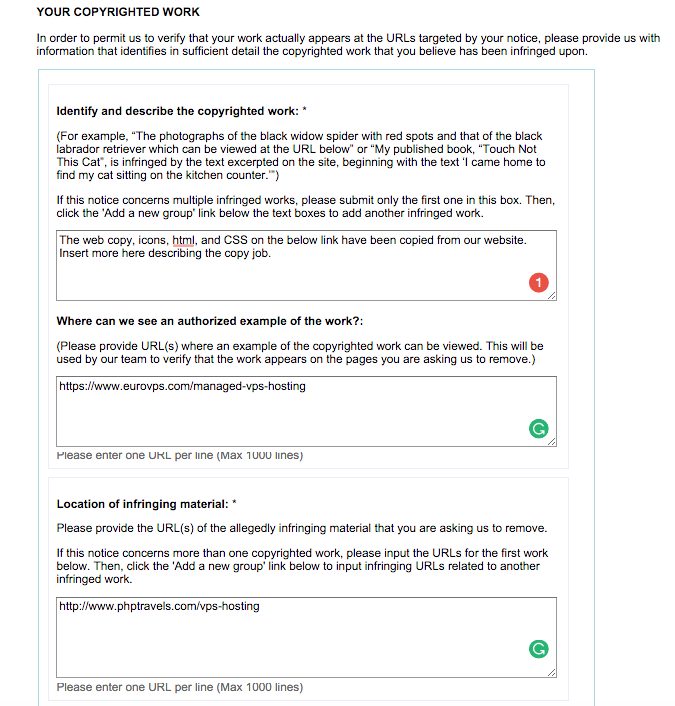
Dealing with Content Ownership Disputes
Sometimes the thief will claim that they were the original creators and that it was you that stole from them.
This is a brazen “right back at you” strategy.
This is a psychological tactic used to intimidate and coerce the victim into a panicked state of mind. It’s pretty stupid if you ask me, but it happens from time to time, especially if the thief senses weakness in the victim.
If you are faced with such a situation you might be furious, shocked, scared, or angry, but it is important to keep calm.
Proving You are the IP Holder
If this happens, you must collect evidence that proves you are the rightful intellectual property holder.
Proving you’re the rightful owner of stolen content is usually very easy to do and will work in your favour as battles like this usually end up in the thief’s site being completely de-indexed from Google.
We recommend using Way Back Machine immediately to see if you can spot the content indexed on your site before an indexation on the copy cat’s site.
Tips to Prepare Yourself for IP Disputes:
- Use the Way Back Machine to prove your page was online first
- Collect documentation proving your journey to create the content in the first place.
- Suitable documentation includes notes, .PSD’s, or any other file that can prove your involvement in the content’s creation
Publically Shame the Thieves
If there ever was an upside to having your content ripped, it’s that you have nothing to be ashamed of.
The thief, on the other hand, can’t exactly say the same.
Point light at it, share it on social media, and spread the word!
Here’s the full thread on LinkedIn.
This will immediately shift the power equilibrium in your favor and it will make it clear who the authority site is and who is the poser.
Recommended Places to Publically Shame Thieves:
- Communities in your industry
- Your Blog
- Quora
How to Prevent Content Theft
Unfortunately, there is no way to prevent all risk of content theft. But you can reduce risk by adding a copyright notice in your terms of services and decrease detection time of content theft by setting up Google Alerts for snippets of your most valuable content.
Ultimately the best defense in this case is a strong offense.
Work hard on your brand positioning to establish yourself as a thought leader in your niche.
Find your blue ocean and the imitators will be powerless.
And remember:
Imitation is the sincerest form of flattery.
